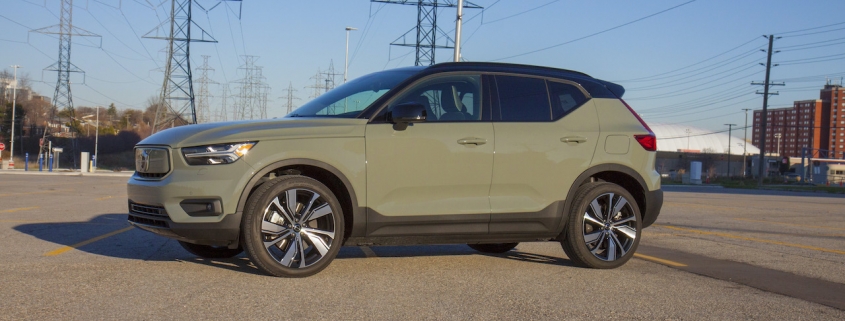Review: 2021 Volvo XC40 Recharge P8
If you weren’t already confused by Volvo’s nomenclature, here’s a new badge to add to the mix – “Recharge”.
Like many other automakers, Volvo’s restructured naming strategy groups type of vehicle together by prefix: S for sedan, V for wagon, and XC for crossover. The badge’s suffix refers to its size. Polestar, formerly reserved for models with a few extra performance tweaks, became a standalone electrified luxury line.
And now along comes “Recharge” which will henceforth be worn by EV versions of models within Volvo’s lineup.
While there are already plug-in hybrid variants of every Volvo, this is their first full-on electric model. It’s underpinned by the same CMA architecture that the regular T5 gasoline-powered XC40 is built upon, which had been specifically designed to accommodate future electrification.
The XC40 was already a favourite in the compact luxury crossover segment, and aside from a few unique features, the Recharge P8 retains the same look. Like most of its ilk, the P8 has a blunt, smoothed over nose rather than an open grille, an exclusive sage green paint scheme, and 19- or 20-inch alloy wheels.
Inside is typical Volvo fare; modern Scandinavian minimalism that would border on austere if not for the sumptuous comfort of its seats. Charcoal is the only colour choice for now, but it’s brightened considerably by a large panoramic glass roof overhead. The focal point of the linear dash is a large, 9-inch vertical tablet-style infotainment screen, and a 12-inch display screen replaces the traditional gauges behind the steering wheel. Such luxury features as panoramic sunroof, heated power seats, and wireless smartphone charging are standard, as well as Volvo’s suite of safety features including adaptive cruise control, lane keeping assist, rear collision alert, and blind-spot and cross-traffic alert.
Powering the connectivity interface is the same Google Android Automotive operating system that made its debut with the Polestar2 (https://www.wheels.ca/news/polestar-2-makes-its-canadian-debut-in-toronto/). It seamlessly integrates phone apps with the vehicle so that you have the option of importing all of your Google calendar appointments, music preferences, and addresses etc. There’s no start button – provided the key is in your pocket, the P8 is ready to go once your backside meets the seat.
The Android OS is easy to use and extremely good at recognizing voice commands. Instead of being offered “Poughkeepsie” no matter how many times I ask for “Peterborough”, a simple “Google, take me to” is all it takes to operate the Navigation system. The Google maps are automatically updated and offer charging station information, and let you know whether you’ve got sufficient battery range to reach your requested destination.
The 78kW battery pack is located underneath the Recharge P8, and doesn’t affect its rear cargo space which Volvo claims is the same 413 litres as the regular variant’s. There’s also a miniscule “frunk” space under the front hood, but it’s handy for storing home charger cables.
The torque delivery is quite astonishing from such an unassuming little vehicle, slamming you into the seat back with its silent thrust. It’s easily modulated though, and with its taut suspension and compact size, the Recharge P8 manoeuvres through congested traffic with quiet efficiency. There are two drive modes: “Normal”, and “One Pedal”, which dramatically slows the car once you lift off the accelerator. While “One Pedal” mode more aggressively reclaims kinetic energy to replenish the battery, “Normal” is smoother and much more pleasant for everyday driving and doesn’t require constant modulating of the accelerator. As expected, it’s supremely quiet, and delivers a premium feel without overt opulence.
The XC40 Recharge’s official range is 335 km, and the battery can be recharged up to 80 percent in one hour using a 150kW Level 3 fast charger. Buyers can opt for a home charger which can replenish the battery overnight in seven to eight hours, or simply plug it into their home grid – if they don’t need their car for the next 24 hours.
A pair of 201 horsepower electric motors mounted at the front and rear axles powers it. Combined, they produce 402 horsepower and a walloping 486 lb-ft of torque, making the Recharge P8 one of the most powerful vehicles Volvo has ever built. Since the P8 can blast from 0-100 km in just 4.7 seconds, this addresses criticism that the XC40 is the least sporty offering in a segment that includes the Porsche Macan, Audi Q3, BMW X1, and Mercedes GLA.
The Recharge doesn’t offer as much range as the less expensive Hyundai Kona EV (415 km), Kia Soul EV (452 km) or the similarly priced Tesla Model Y Long Range, but feels a lot more luxurious.
Pricing starts at $64,950, which is a rather astonishing $25,000 more than the conventional gasoline powered XC40. It’s also above the $45,000 price limit for the $5,000 federal rebate, and British Columbia’s $55,000 for provincial rebate. However, Quebec buyers qualify for up to $8,000 on vehicles up to $75,000 – which coupled with the federal incentive could add up to $13,000 off purchase price. When you compare it to the $111,500 you’d pay for competitor Audi E-tron – that makes the XC40 Recharge seem downright frugal.
The XC40 Recharge P8 is the first of five full-on electric battery EVs Volvo plans to launch over the next five years, by which time Volvo claims that half of their vehicle production will be electrified. It’s a solid first step
The vehicle was provided to the writer by the automaker. Content and vehicle evaluations were not subject to approval.
The post Review: 2021 Volvo XC40 Recharge P8 appeared first on WHEELS.ca.






